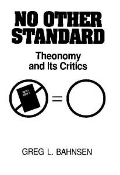No Other Standard: Theonomy and Its Critics. By Greg L. Bahnsen. Tyler, TX: Institute for Christian Economics, 1991. 345 pp. Paper, $9.95.
No Other Standard is a response to the various objections that have been leveled at Bahnsen’s first book, Theonomy in Christian Ethics (Nutley, New Jersey: The Craig Press, 1977) and to theonomy in general.
Theonomists hold that OT moral principles and regulations are still binding today, unless they are specifically annulled in the NT. Theonomy states that only the ceremonial aspects of the law have been abolished. This means that the moral and civil aspects of the law are still binding. The insistence of the theonomists on the continuing validity of the penal sanctions in the Mosaic Law is their most notable distinction. These require the death penalty for working on the Sabbath, homosexuality, adultery, witchcraft, idolatry, blasphemy, and even for incorrigibly disobedient children, to name a few. Theonomists believe that Scripture is the only objective standard on which government should be based. This is probably the greatest strength of theonomy in that it seeks to apply the Bible to the issue of punishment for crime in society. However, as stated above, this entails more than just rape, murder, theft, etc., but also prosecution for religious crimes.
The two lines of opposition against theonomy come from dispensationalists and from Reformed circles. Dispensationalists argue that the Mosaic Law as a system or rule of life is abrogated. The Reformed view does recognize distinctions in the law, but disagrees with theonomy in saying that we are not under the penal sanctions, but only the moral aspects of the law. Bahnsen is answering the various objections to theonomy from these two camps.
The introduction gives a synopsis of theonomy. Bahnsen then argues for several chapters against misrepresentations of his perspective. The rest of the book is given to weightier objections to his view. These entail the validity of dividing the law, Dispensationalism, Israel’s uniqueness, separation of church and state, pluralism, and other issues of the penal code. There is also an exegesis of Matt 5:17–19 in Appendix A.
Dispensationalism is diametrically opposed to theonomy. The passages that specifically speak to the believer’s relationship to the law are the key passages in this discussion. Theonomy understands them to refer only to the ceremonial aspects of the law (cf. Rom 6:14, Gal 3:23–25, 1 Cor 9:19–23, Rom 7: 4–6, Eph 2:14–22, Col 2:13–14, Matt 5:17–19, and 2 Cor 3:6–18). However, the texts in question do not specify this category. There are texts in which the writer makes application to the ceremonial aspects of the law, but this is not the same as saying that only the ceremonial aspects of the law are abolished. Romans 6:14 makes no reference to any particular aspect of the law. Second Corinthians 3:7 makes specific reference to the decalogue itself.
Bahnsen’s defense against the problem of enforcing the Mosaic death penalties on unbelievers for religious crimes is inadequate. He believes society will be converted and sanctified to desire God’s laws. He also believes that society will hear and fear the law. This seems reminiscent of postmillennial doctrines.
Bahnsen does not discuss Rom 10:4 or 2 Cor 3:6–18, key passages in the discussion of the law’s application in the NT. Discussion of these passages is essential for one espousing theonomy. The book is well written overall, though, and is very challenging reading. It should be read by every believer who is interested in the relevance of the Mosaic Law today.
R. Michael Duffy
Editorial Board
Journal of the Grace Evangelical Society
Dallas, TX

